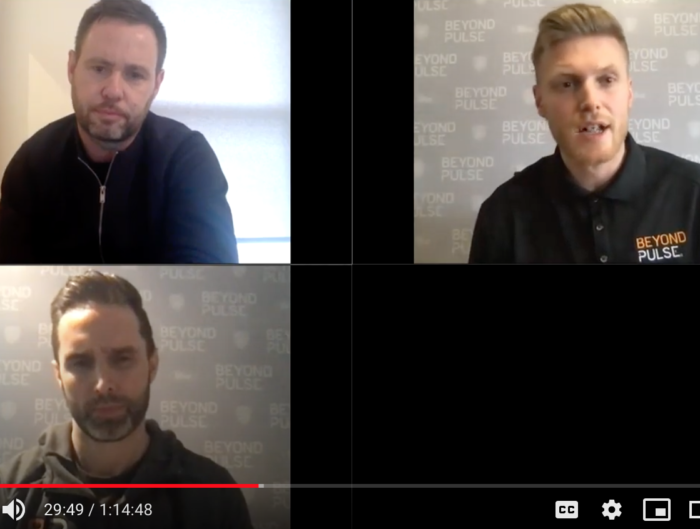With the Winter season fast approaching we know that usually means a reduction in both training frequency, space and time. Unfortunately clubs simply do not have the facilities to accommodate the same type of training regimen that we see in the Fall and Spring seasons. While clubs in Florida, Arizona or California may be more fortunate, the reality for many other coaches is the familiar conundrum below…
How do I maximize decreased contact time with my players, in smaller areas, across a period of time that is the same length as the Fall and Spring seasons?
If we do not capitalize on this time with our players, we run the risk of not just under-preparing them for the season ahead, but also failing to capitalize on a key window of opportunity for improvement.
At Beyond Pulse our coach/session reports are designed to provide the type of easy-to-understand and actionable data that will help coaches understand whether or not they are achieving their goals.
This short article discusses the importance of two specific data points – Active Participation (AP) and Heart Rate (Time above 80% of Max HR). We will use both as clues for whether the practices you design and deliver are effective in supporting your players. We will also share some factors to consider when planning your practices during this tricky time period.
Active Participation
Coaches often wish they had more contact time with their players throughout the winter/indoor season. One of the major questions we pose to these coaches is, “What Are You Doing With The Time That You Do Have?”
Our AP metric allows coaches to understand how active and a player was within a session or game. Think back to coaching schools where an instructor had a stopwatch and recorded how long each coaching intervention was. Or how long players were stood still as you spoke etc? Well, this metric does that for you. We consider AP the most impactful for coaches becoming more self-aware of the quality of their practices and the behaviors exhibited.
In the winter season it is incredibly easy to think “I have a small space and a large group of players. So my solution is to play a three-team rotation game with one team sat out”. Alternatively, it might be that we are in a small space so I can only really do“technical”exercises in lines. My question to you would be, is it acceptable for a player to be sat out for one-third of their practice, or to only be the active player 1 every 3 repetitions especially when their training load is likely already reduced because of lighter schedules in the winter?
Our advice is to consider a number of other factors instead. For example, can you play multiple smaller number training games? Can you include players as active rest players (bounce players or targets), can you limit the length of your coaching interventions and transition moments between activities, to increase the time players have to play? Can you use a carousel of coaching behaviors so that your intervention strategy is based more around coaching over the top, using individual reference as opposed to larger freeze moments that take time away from the players?
Critical to this is your ability to purposefully plan how you intend to deliver your session. Many people think planning is simply preparing the activities or games that your players are going to participate in. We would challenge you to also think about the coaching behaviors you are going to use? What are your key coaching points and when do you expect to make them based upon the activities you are delivering? What is your work to rest ratio for the activities and how can you use this rest time to offer opportunities for coaching to be delivered? Or for your players to collaborate in reflecting on the game being played and perhaps solve problems independently?
Recognizing the individual nuance in how players engage and learn during your sessions and even in rest periods will help you put the player at the center of the learning journey. It is okay to leave some of your planned content and stoppages on the sidelines for another day if the rhythm, tempo, and level of enjoyment are evident in your practice activities.
Heart Rate
Consider this scenario. It is the Winter and your team has dropped down to two practices per week, both taking place in small areas, a fraction of the size you may usually train over. There are no games at the weekend (at least not full-sided games) and with snow on the ground and other extracurricular activities limited, your players are not their usual active selves. If we deliver practice sessions that do not require a high degree of physical exertion we run the risk of our players regressing significantly in terms of their state of physical readiness. With scatterings of College Showcase events taking place in the warmer climates throughout these months, should you find yourselves in the less temperate states, your team’s ability to be “soccer fit” is already limited. Practices that are not physically demanding will only amplify that further.
It is not uncommon to see players go from spending 40 minutes in their “Red Zone” (time above 80% of their Max HR) when training outside, to just 4 minutes when moved inside to train. Obviously, the compounding impact of this type of training return would be significant if it were witnessed over a sustained period of 2-3 months.
For this reason, the considerations spoke of earlier that help guarantee the tempo and flow of a session are important. Additionally, so too are the types of constraints or challenges you can place on a session to help promote intensity.
If your ability to modify the training environment is impaired, perhaps you might think about emphasizing the next two items. You might tweak the time allocated to a task? For example, if a team can regain possession after losing it within five seconds or five passes, they earn a point. You might also tweak the challenges faced by a player. For example,.if a team can score with all their players in the attacking half of the field, the goal is worth double. Obviously, these types of constraints would depend on your game model, but you are invoking an increase in intensity being witnessed should the players embrace these challenges.
When the environment you are working in inherently presents challenges you may want to ask yourself these two questions. Are you comfortable with delivering sessions that are adequate and probably still help your players develop in some ways? Or do you choose to be excellent and challenge yourself to intentionally tweak your coaching process and create activities that bring out the best in your players to keep them engaged and as ready as possible for their return to the field?
I’m sure you may have shown your players the quote below one or two times. Winter is a time where it also rings true for us as coaches.
“Everyone wants to be great until it’s time to do what greatness requires.”
Winter is a time where your players require and deserve your greatness. Hopefully, aided with some of the ideas shared here you are able to give it to them! Please consider these suggestions and share with us your highest AP or HR sessions – we would love to see them!

 FRA
FRA































